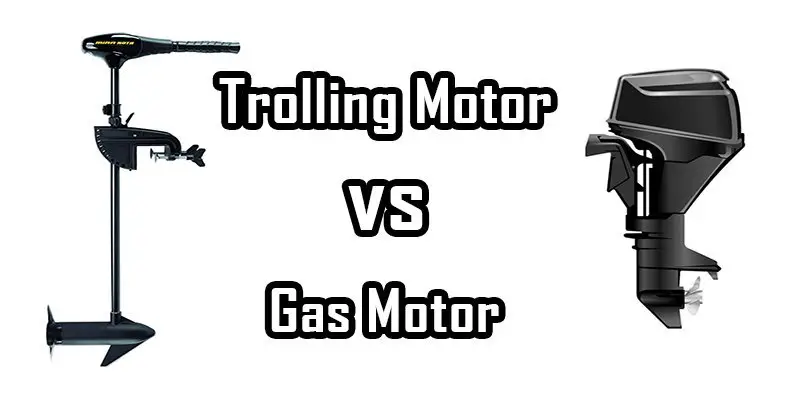Are you confused about choosing the appropriate motor for your tinny vessel? Here we are going to tell trolling motor vs gas motor comparison, where you may find the right answer for your confusing mind.
A fishing method is known as trolling. O. G. Schmidt invented a trolling motor in 1934 for the boats used for fishing. It affixed on the bow or stern of a fishing boat. Cameron Waterman invented a gasoline-powered outboard motor in 1903. Lehr inc modified petrol engines to propane gas engines. Tohatsu recently applied LP gas for outboard motors. In this article, you will find knowledge about features of trolling motor and gas motor, comparison between them, and which one you may choose.
Features: Trolling Motor & Gas Motor
Before comparing, we should know about the two products. Here we are describing trolling motor and gas motor features.
Trolling Motor
One of the purposes of inventing a trolling motor was to move a boat quietly and to avoid fearing fish. It is a small electric motor. It consists of an engine, propeller, and controller.
The motor generates power from rechargeable batteries- the motor sealed inside a watertight chamber of the edge of the shaft. So, it is under the water during operation and protects from overheating.
There are three styles of steering of a trolling motor. These are- a tiller handle, foot pedal, and remote controlling device. You may choose any of them.
The propeller fits with the prop shaft. ‘12-volt, 12/24-volt, 24-volt, 36-volt’ configurations are available for a trolling motor. The more voltage you want, the larger motor you need. More voltage gives more power to the propeller. The speed measured in ‘pounds of thrust.
Gas Motor
A gas motor conducted by gaseous fuel. The fuel may be coal gas, landfill gas, biogas, natural gas, etc. The gas injects into a tank located on top of the motor. The bigger tank holds a lot of gas. The gas motor features an engine, a tiller handle, a mounting bracket, an anti-ventilation plate, a water intake port, a propeller, and a skeg.
After starting the motor engine, it burns fuel and makes power. A piston turns the crankshaft into a round motion; the crankshaft makes running down the central driveshaft. A gearbox of the driveshaft starts horizontally spinning, and it powers the propeller. The propeller runs the boat on the water. You can control your vessel by a handle or by a foot pedal. The speed measured in horsepower (hp).
Comparison Table – Trolling Motor Vs Gas Motor
Here we are focusing on the differences between trolling motor and a gas motor with a table. So, you can compare easily.
Trolling motor |
Gas motor |
| Price is at hand. | Little expensive. |
| Take a long time to recharge and have to charge fully before starting the journey. | Fuel is portable and easy to fill the tank. So, users can take extra gas for a long tour. |
| Stop the blade automatically while stuck with something like rocks. | Not stop in auto, even the blade can break if stuck with something hard. |
| A very special or expensive trolling motor can operate through saltwater.
Most of the trolling engines are appropriate for freshwater. |
The gas motor is usable for saltwater. |
| Do not pollute water and the environment. | Cause of environmental pollution. |
| The batteries are located on the boat, outside of the motor. So, it occupies a new place. | The fuel tank is inside the motor. It does not take extra space. |
| Little unavailable at the recharge station. | A refuel station is available. |
| Speed is a little less-faster than a gas motor. | Gas motors go faster than trolling. |
| Usually, a trolling motor is suitable for a smaller boat. | The gas motor can be used for both small and big boats. |
Details of Trolling Motor

Generally, to move your boat, you need 5′ pounds of thrust’ for every 400 pounds. A 12-volt battery produces 50 pounds of thrust. A trolling motor could go five mph at maximum speed.
Pros:
- Not noisy.
- No bad smell.
- Start quickly.
- Safe for plastic boats, canoe, kayak, etc.
Cons:
- Batteries are a little heavy.
- May not be supportive of a long-distance trip.
Details Of Gas Motor

Usually, E10 gasoline is used for a gas motor. It contains ethanol (10%) and gasoline (90%). There is two-stroke, and four-stroke engines are available.
If a gas motor was maintained rightly, it would run for 15,000 hours, which means 7 to 8 years.
Pros:
- Lightweight.
- Suitable for saltwater.
- Few amounts of fuel support long distance.
- No need for an extra chamber for a battery.
Cons:
- Noisy and bad smell.
- Not safe for shallow water.
Which One You Should Select
Before making sure which type of motor you should buy, you have to know the answer to some questions.
- What is the height and weight of your boat?
- How long may you go?
- Which type of water may go?
The shaft length of the motor depends on the height of the boat. The shaft must be in the proper size to conduct a vessel.
For example, depending on 0″-10″ the transom of the waterline recommends a 30″ shaft length. On the other hand, 0″-10″ bow to the waterline suggests a 36″ shaft length. This measurement is for trolling motors. For gas motors, the cavitation plate must be 13″ minimum to the waterline.
Besides shaft length, power is more important to choose a motor. If you go for a trolling engine, the more voltage-powered battery gives more control.
On the other hand, more gas runs the motor for more time. In short, get the highest output motor according to your budget.
If you use the boat to the saltwater, the gas motor is the best choice. If you don’t like noise and a bad smell, you should choose a trolling motor.
Frequently Asked Questions (FAQs)
Could we use diesel instead of gas to run the gas engine?
What size of a trolling motor is suitable for a boat?
Conclusion
Before the invention of the motor engine, the boats were man-powered with oars or sails. Though that was eco-friendly, that was hard work too. The motors make running a boat more manageable. Nowadays, inventors are searching for environment-friendly engines.
If you are thinking of mounting a motor with your boat, this article is a guideline for you. Trolling motor vs. gas motor comparison will help you to choose what you need. So, let’s get your engine and enjoy the ride.
- MarCum Vs Vexilar – Which One is Winning!
- Lipless Crankbait Vs Rattletrap – Which is ahead in the competition!
- Square Back Canoe VS Regular Canoe – Choose The Right One
- Creek Boat Vs River Runner – Which Is Best For You
- Choose the 5 Best Trolling Motor for Pelican Bass Raider
- 5 Best Outboard Motor for Canoe With Full Reviews
- 5 Best 12 Volt Trolling Motor Battery to Try in Budget
- How To Tie Down A Kayak With Foam Blocks Easily

